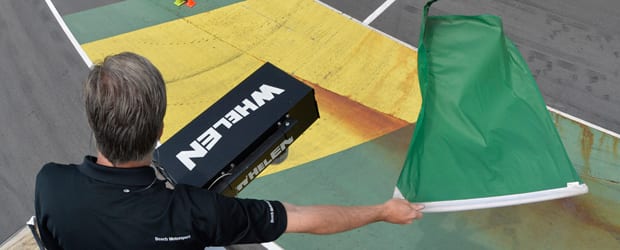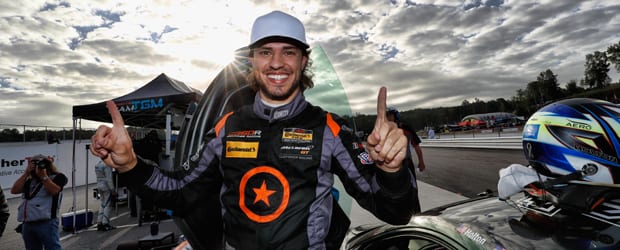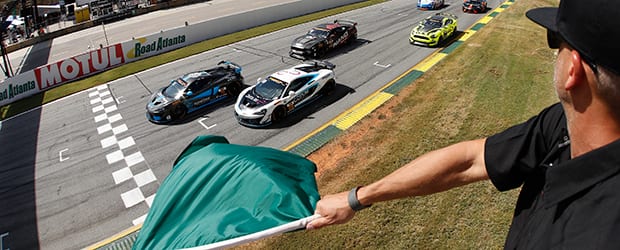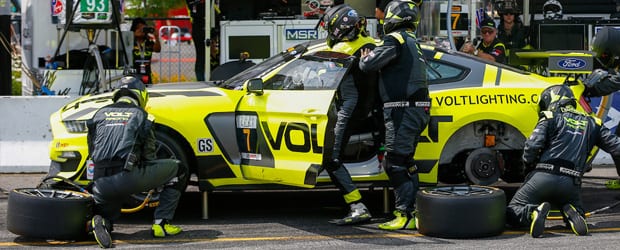IMSA MICHELIN PILOT CHALLENGE UNDERSTANDING THE SPORT
FLAGS

 GREEN: Waved at the start of the race, practice or qualifying session, or at the restart following a full-course caution.
GREEN: Waved at the start of the race, practice or qualifying session, or at the restart following a full-course caution.
 RED: Displayed at start/finish to stop the race or session for safety reasons or because of weather conditions. All competitors must proceed to the pits and be prepared to stop at any time.
RED: Displayed at start/finish to stop the race or session for safety reasons or because of weather conditions. All competitors must proceed to the pits and be prepared to stop at any time.
 YELLOW: When held stationary at any of the flag stations around the track, it means there is danger and to slow down and keep your track position in that part of the track due to an incident in the area. A waving yellow also signifies extreme danger and/or course workers on the course.
YELLOW: When held stationary at any of the flag stations around the track, it means there is danger and to slow down and keep your track position in that part of the track due to an incident in the area. A waving yellow also signifies extreme danger and/or course workers on the course.
 DOUBLE YELLOW: Signifies a full course caution when displayed at Start/Finish or around the course. All cars must slow and maintain their position in line behind the pace car.
DOUBLE YELLOW: Signifies a full course caution when displayed at Start/Finish or around the course. All cars must slow and maintain their position in line behind the pace car.
 YELLOW FLAG WITH RED STRIPES: Displayed when there is a slippery surface or debris on the track.
YELLOW FLAG WITH RED STRIPES: Displayed when there is a slippery surface or debris on the track.
 BLUE: Alerts drivers that faster traffic is approaching. If waved, the competitor must give way to the driver trying to pass.
BLUE: Alerts drivers that faster traffic is approaching. If waved, the competitor must give way to the driver trying to pass.
 BLACK: When displayed to field, competitors must proceed to the pits. A black flag displayed to a single competitor indicates that a driver must report to the pits immediately due to a rule infraction; if displayed to a competitor in a furled manner, the competitor is warned to discontinue an act of unsportsmanlike conduct or they will be penalized. Stationary black flags are held around the course when the red flag is displayed at start/finish, warning drivers that they are to reduce speed, head to the pits and may be stopped at any time
BLACK: When displayed to field, competitors must proceed to the pits. A black flag displayed to a single competitor indicates that a driver must report to the pits immediately due to a rule infraction; if displayed to a competitor in a furled manner, the competitor is warned to discontinue an act of unsportsmanlike conduct or they will be penalized. Stationary black flags are held around the course when the red flag is displayed at start/finish, warning drivers that they are to reduce speed, head to the pits and may be stopped at any time
 BLACK WITH ORANGE DISK (MEATBALL): Driver must report to the pits due to a mechanical problem.
BLACK WITH ORANGE DISK (MEATBALL): Driver must report to the pits due to a mechanical problem.
 WHITE: Waved at Start/Finish with one lap to go; when held stationary, indicates an emergency vehicle on the course or a much slower race car ahead.
WHITE: Waved at Start/Finish with one lap to go; when held stationary, indicates an emergency vehicle on the course or a much slower race car ahead.
 CHECKERED: Waved at the finish of the race, practice or qualifying session.
CHECKERED: Waved at the finish of the race, practice or qualifying session.
QUALIFYING PROCEDURES & RACE STARTS
Qualifying Procedures

After several practice sessions and prior to a race, cars participate in a brief, yet critical, qualifying session that determines where each car will start the race. As the race unfolds. the advantage of having a better starting position can pay huge dividends.
Qualifying is divided into 15-minute segments for each IMSA Michelin Pilot Challenge class. The driver with the fastest lap in each session earns the Motul Pole Award and starts the race in first. The second fastest qualifier starts second, and the process continues based on lap times until the grid is complete.
Per the rules, only one driver is allowed to qualify the car and it is not mandatory to use the entire 15-minute session. Drivers may also come in and out of the pits to make minimal adjustments with the permission of IMSA officials.
If qualifying is canceled, starting grids are set by team points and if a driver causes a red flag during qualifying, that driver will lose their fastest lap from the qualifying session.
Race Starts

Prior to every event, the IMSA Michelin Pilot Challenge gives spectators the opportunity to see the cars up close and meet their favorite drivers during an Open Grid/Fan Walk. The cars are lined up based on qualifying results, with the fastest overall car starting from the pole position, the second fastest qualifier starting second, and continuing until the grid is complete.
Competitors are always reminded that it’s impossible to win a race in the first turn of the first lap – but it’s very easy to lose one there.
For the drivers, with anticipation building on the grid, then the command to start the engines, and the adrenaline surging throughout the formation laps, many of them sometimes throw caution to the wind and sprint towards the first turn as quickly as possible.
As a result, race starts can be one of the most thrilling parts of the sport and potentially a turning point early in the race.
PIT STOPS

Imagine filling up your car and changing all four tires in less than 25 seconds. That’s exactly what happens during an IMSA Michelin Pilot Challenge pit stop – and much more.
What To Watch For:
No one is allowed over the wall until the car comes to a full stop.
Four crewmen are then designated to perform routine tasks on the car, such as refueling and tire changes. The crew can also service other mechanical work if necessary, including changing brake pads and rotors, adjusting the aerodynamic wing, and repairing any damage from contact.
If a driver change is taking place, one crewman is allowed over the wall to assist in connecting the incoming driver’s radio, air hoses, drink tube and safety belts. A minimum of two drivers are required for every race – with up to three to five drivers used in the endurance races at Daytona International Speedway and Indianapolis Motor Speedway.
A speed limit of 60 kilometers per hour is strictly enforced for all cars driving in the pit lane. Anyone caught speeding must serve a drive-through penalty down pit lane or risk being black flagged during the race.